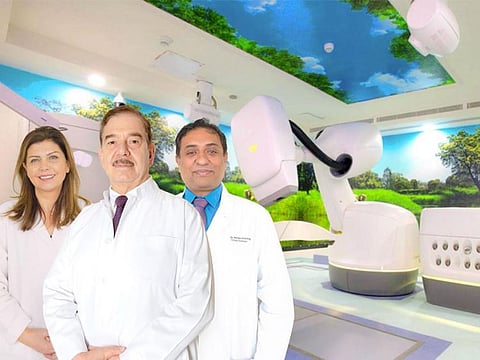Dubai hospital introduces Cyberknife surgery to deal with inoperable tumours
Stereotactic radiotherapy offers new hope to cancer patients with painless treatment

Dubai: It was early 2019, just a couple of years after her graduation. Farah Qureshi, then 24, was quite a livewire, bursting with energy and looking forward to an exciting career. She had some experience at work and with that, she moved from India to UAE to join as a customer service executive with an online food delivery app. With some routine gynaecological and hormonal issues, Qureshi visited her gynaecologist, little knowing that her problems lay elsewhere. The idea of sickness or disease was the furthest from her at that point of time.
A numb left foot led to meningioma diagnosis
Qureshi recounted her story to Gulf News: “I did have occasional headaches and fatigue. However, I could never have imagined that what seemed to be a minor issue turned out to be a brain tumour! It was a numbness in my left leg that prompted the doctor to advise me to seek neurological consultation. A few diagnostic tests later, it was revealed that I had a meningioma! No one in my family had ever had a history of tumours and I was just shell-shocked by this diagnosis, to say the least.”
Despite her initial response, the young executive, supported by her family and workplace, went in for a traditional surgery in 2019. “It was mid-March and the neurosurgeons who opened my skull, soon realised that my tumour had many vital blood vessels involving my thalamus and brain stem tightly wound up around it. Operating on it could have meant losing vital functions such as my ability to walk!” Qureshi recounted.
An inoperable tumour
The young girl had no idea what needed to be done. Her tumour was growing by a few millimetres with every passing day. By mid-2021, when she turned 26, her tumour had grown to 2.7mm. Fortunately, for Qureshi, her health insurance provider too researched on it and told her about the unique CyberKnife technology available at Dubai’s Neuro Spinal Hospital. Qureshi met the medical team comprising Dr Abdul Karim Msaddi, chief neurosurgeon and medical director, Dr Nandan Shanbag, clinical oncologist, and Dr Salam Yanek, radiation oncologist. The doctors decided it was worth an attempt to shrink the tumour non-invasively.
Cyberknife to the rescue
In December 2021, Qureshi underwent a painless, bloodless, non-invasive surgery (precision irradiation, which was able to irradiate the tumour with sharp precision even while sparing the rest of the area of her brain around it. “It is too early to have a complete picture, but in the last three months my tumour has stopped growing! I have got back to normal work and feel fine,” reported Qureshi who underwent three irradiation cycles, which she reported were without anaesthesia or any pain.
“There was some brain swelling, which can be a likely side-effect of irradiation. In my case, it was expected and I was put on steroids. The swelling subsequently subsided. I underwent MRI scans three months after the surgery. My tumour was expected to shrink in three months’ time. Right now, I am very cautious, but I feel no deterioration in my condition,” said the brave young patient had resumed normal working life.
Qureshi is not the only patient treated at Neuro Spinal Hospital. Since June 2021, since the CyberKnife was introduced, about ten patients have undergone successful treatment and are at various stages of recovery. They are being monitored closely and evaluated on their progress.
What is CyberKnife?
Professor Dr Mssaddi, explained: “The CyberKnife is a patented robotic assisted radio surgery. As of now, in entire UAE, it is only available at the Neuro Spinal Hospital. This is an advancedm non-invasive alternative to surgery for the treatment of benign or malignant tumours anywhere in the body such as the brain, spine, lung and the prostate gland. It is mostly used in cases where such tumours are inoperable the conventional way.”
How does it work?
Dr Shanbag, explained: “The CyberKnife treatment system is akin to having your X-ray taken. It works by delivering high doses of radiation to irradiate a tumour with extreme accuracy, ensuring that no harm is done to surrounding healthy tissue. “
He further said: “It uses sophisticated image-guidance and computer-controlled robotics to deliver multiple beams of radiation to the tumour from virtually any direction with extreme accuracy. It is able to track the tumour’s position and continue to track it and correct for position changes during patient movement and breathing.
Dr Yanek added that there were some clear advantages for this surgical method, which is covered by most health insurances. “It is pain-free, non-invasive, can be carried out without anaesthesia in one to five sittings maximum, in an outpatient procedure. Since there are no cuts, recovery time is quick. With more than two decades of clinical proof worldwide, the CyberKnife can not only offer new hope to patients with surgically inoperable or complex tumours, but can also help avoid post-surgical complications arising due to anaestheisa or infection or pain management.”
Sign up for the Daily Briefing
Get the latest news and updates straight to your inbox



